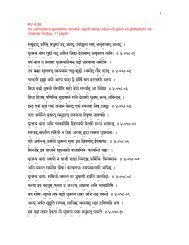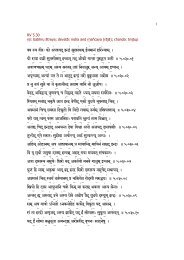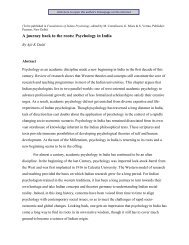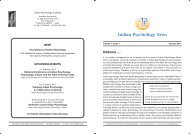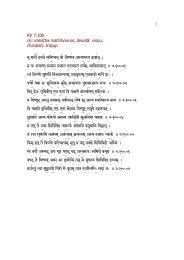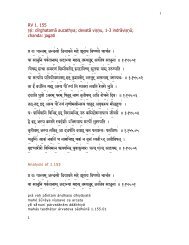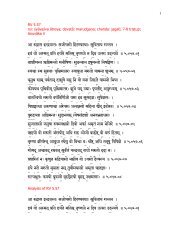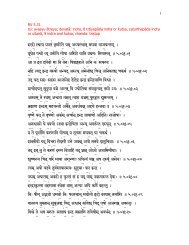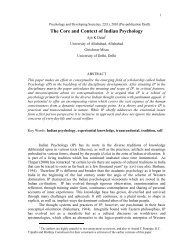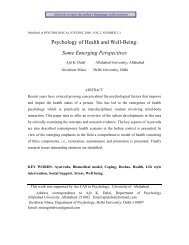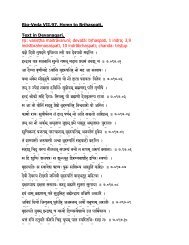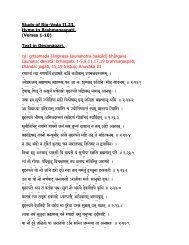Anasakti and health: A study of non-attachment - Indian Psychology ...
Anasakti and health: A study of non-attachment - Indian Psychology ...
Anasakti and health: A study of non-attachment - Indian Psychology ...
Create successful ePaper yourself
Turn your PDF publications into a flip-book with our unique Google optimized e-Paper software.
90This <strong>study</strong> embodies transition <strong>of</strong> thoughts across distinct theoreticalframeworks. Concepts belonging to the domains <strong>of</strong> philosophy,mysticism <strong>and</strong> psychology have all been invoked with the aim <strong>of</strong>underst<strong>and</strong>ing the stress process. The seeming theoretical inconsistencymay be viewed as an initial step towards achieving adynamic synthesis <strong>of</strong> these different streams <strong>of</strong> knowledge.Although most indigenous systems are traditional, their interpretationin terms <strong>of</strong> contemporary language <strong>and</strong> vocabulary is adistinct possibility (Paranjpe, 1988). Since the process <strong>of</strong> indigenisationalso refers to indigenisation <strong>of</strong> research methodology,skepticism regarding the appropriateness <strong>of</strong> adopting empiricalmethods to underst<strong>and</strong> indigenous concepts which may not lendthemselves to their operationalistic orientation, is not unwarranted.Nonetheless, the decision to <strong>study</strong>ing indigenous concepts with thehelp <strong>of</strong> empirical methods can be taken. At astage where&dquo;...indigenisation has hardly passed beyond the embryonic stage <strong>of</strong>development...&dquo; (Ho, 1988, p. 54), this decision may be less appropriatebut more strategic. It may encourage the advocates <strong>of</strong>empiricism to look for concepts embedded in their own culturalheritage <strong>and</strong> in the process, it maysave those ancient texts frombeing subjected to the iconoclastic destruction by the present daynihilism, the &dquo;materialistic scientism&dquo; (Schumacher, 1977, p. 4).Before working out the implications <strong>of</strong> anasakti in the stressprocess, a brief description <strong>of</strong> the philosophical framework <strong>of</strong>anasakti will be presented here.According to almost every system <strong>of</strong> <strong>Indian</strong> philosophy, whetherorthodox or heterodox, realistic or idealistic, the purpose <strong>of</strong>human life is to achieve liberation from sufferings <strong>and</strong> realise theidentity <strong>of</strong> self with the Ultimate Reality. To be able to achieve thegoal <strong>of</strong> self-realisation, disengagement <strong>of</strong> consciousness fromdesires is necessary. Desires, which are directives <strong>of</strong> the senses,spring from the identification <strong>of</strong> self with the ego <strong>and</strong> its concerns<strong>of</strong> ambition, pride, <strong>attachment</strong> (asakti) <strong>and</strong> insistence on mineness(mamatva). For this <strong>study</strong>, description <strong>of</strong> anasakti given in theBhagvad Gitä was examined. The reason for selecting the BhagvadGitd over other sources was simple. The Bhagvad Gïtä describesanasakti in great thoroughness <strong>and</strong> works out the various conceivableramifications <strong>of</strong> the concept in all their details.In the Gita, the ideal <strong>of</strong> anasakti embodies the principles <strong>of</strong> spiritualismas well as exhortations to pragmatism <strong>and</strong> action orientation.Downloaded from pds.sagepub.com by Ajit Dalal on April 4, 2011



